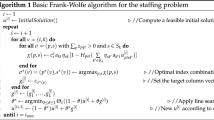Abstract
We consider the problem of simultaneously scheduling IT-projects and assigning multi-skilled internal and external human resources with resource-specific efficiencies to the project work. The objective is to minimize labor costs. The problem is modeled as a mixed-integer linear program (MIP) with a tight LP-bound. The performance of the model w.r.t. solution gap and computation time is assessed and managerial insight is given concerning different problem parameters such as the time window size of projects, the number of skills of human resources, and the workload. Furthermore, we show the benefit of applying the MIP compared to simple heuristics used in practice in terms of obtaining feasible and low-cost solutions. Finally, we provide insight into the benefit of applying the MIP in case of central compared to decentral planning.
Similar content being viewed by others
References
Alba E, Chicano FJ (2007) Software project management with GAs. Inf Sci 177(11): 2380–2401
Alfares H, Bailey J (1997) Integrated project task and manpower scheduling. IIE Trans 29(9): 711–717
Ballou D, Tayi G (1996) A decision aid for the selection and scheduling of software maintenance projects. IEEE Trans Syst Man Cybern Part A Syst Hum 26(2): 203–212
Bassett M (2000) Assigning projects to optimize the utilization of employees’ time and expertise. Comput Chem Eng 24(2–7): 1013–1021
Bellenguez-Morineau O, Néron E (2007) A branch-and-bound method for solving multi-skill project scheduling problem. RAIRO Oper Res 41(2): 155–170
Brucker P, Drexl A, Möhring R, Neumann K, Pesch E (1999) Resource-constrained project scheduling: notation, classification, models, and methods. Eur J Oper Res 112(1): 3–41
Cai X, Li K (2000) A genetic algorithm for scheduling staff of mixed skills under multi-criteria. Eur J Oper Res 125(2): 359–369
Campbell G (1999) Cross-utilization of workers whose capabilities differ. Manage Sci 45(5): 722–732
Campbell G, Diaby M (2002) Development and evaluation of an assignment heuristic for allocating cross-trained workers. Eur J Oper Res 138(1): 9–20
Corominas A, Ojeda J, Pastor R (2005) Multi-objective allocation of multi-function workers with lower bounded capacity. J Oper Res Soc 56(6): 738–743
Corominas A, Pastor R, Rodriguez E (2006) Rotational allocation of tasks to multifunctional workers in a service industry. Int J Prod Econ 103(1): 3–9
Dodin B, Elimam A (1997) Audit scheduling with overlapping activities and sequence-dependent setup costs. Eur J Oper Res 97(1): 22–33
Drexl A (1991) Scheduling of project networks by job assignment. Manage Sci 37(12): 1590–1602
Ernst A, Jiang H, Krishamoorthy M, Sier D (2004) Staff scheduling and rostering: a review of applications, methods and models. Eur J Oper Res 153(1): 3–27
Garey M, Johnson D (1979) Computers and intractability—a guide to the theory of NP-completeness. W.H. Freeman, New York
Gutjahr WJ, Reiter P (2008) Bi-objective project portfolio selection and staff assignment under uncertainty. Technical report, Universität Wien
Gutjahr W, Katzensteiner S, Reiter P, Stummer C, Denk M (2008a) Competence-driven project portfolio selection, scheduling and staff assignment. Cent Eur J Oper Res 16(3): 281–306
Gutjahr WJ, Katzensteiner S, Reiter P, Stummer C, Denk M (2008b) Multi-objective decision analysis for competence-oriented project portfolio selection. Technical report, Universität Wien
Taylor B, Moore L, Clayton E (1982) R&D project selection and manpower allocation with integer nonlinear goal programming. Manage Sci 28(10): 1149–1158
Vairaktarakis G (2003) The value of resource flexibility in the resource-constrained job assignment problem. Manage Sci 49(6): 718–732
Valls V, Pérez A, Quintanilla S (1996) A graph colouring model for assigning a heterogeneous workforce to a given schedule. Eur J Oper Res 90(2): 285–302
Valls V, Pérez A, Quintanilla S (2009) Skilled workforce scheduling in service centers. Eur J Oper Res 193(3): 791–804
Wu M-C, Sun S-H (2006) A project scheduling and staff assignment model considering learning effect. Int J Adv Manuf Technol 28(11–12): 1190–1195
Yoshimura M, Fujimi Y, Izui K, Nishiwaki S (2006) Decision-making support system for human resource allocation in product development projects. Int J Prod Res 44(5): 831–848
Author information
Authors and Affiliations
Corresponding author
Rights and permissions
About this article
Cite this article
Heimerl, C., Kolisch, R. Scheduling and staffing multiple projects with a multi-skilled workforce. OR Spectrum 32, 343–368 (2010). https://doi.org/10.1007/s00291-009-0169-4
Published:
Issue Date:
DOI: https://doi.org/10.1007/s00291-009-0169-4




